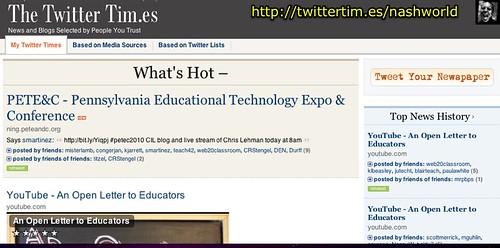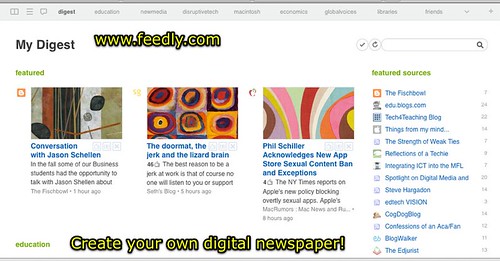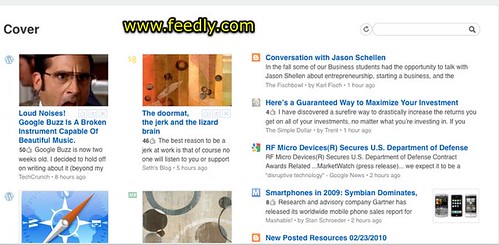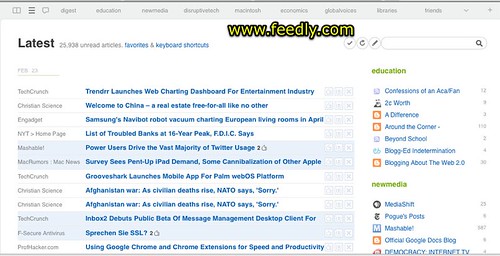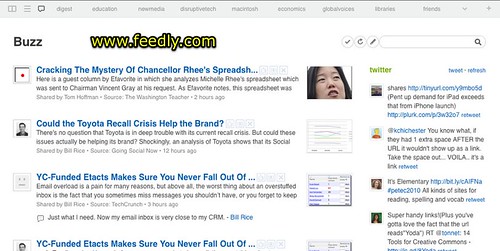Analogies can help us understand new concepts. I’m fond of talking about “digital newspapers” rather than aggregators or feed readers when helping learners of any age understand how web tools like Google Reader and Netvibes can become valuable parts of our personal learning landscape. WHERE do you learn today? For me, I increasingly learn a LOT every day on my screens. That is not just limited to my laptop, but also includes my smartphone (an iPhone) and the television. Of these, the iPhone and my laptop top the list in terms of both time spent “on screen” as well as the quantity and quality of information consumed. While there are some great programs on television and a digital video recorder (DVR) can make them accessible “on demand,” in general I find far less value from traditional broadcast media sources than IP-based / online ones. I prefer interactive screens to passive ones as well, since I can share and better process content on them.
This week I listened to episode 30 of the Shifting our Schools podcast, which focused on the question, “How to recruit to be an international educator?” The SOS podcast is a creation of Jeff Utech and David Carpenter. Near the end of the podcast, Jeff shared the website The Twitter Times. The site is:
…a real-time personalized newspaper generated from your Twitter account.
My Twitter Times newspaper is “still being built,” but it should be ready later today! Here’s a screenshot of Sean Nash’s:
It’s interesting to hear other people (including folks outside educational circles) talk about Twitter, and gain insight into their perceptions of it. Last night at our Oklahoma City WordPress user’s group meeting, one of the presenters admitted “I don’t get Twitter” and described it as a place where people just post stuff. Certainly “the good stuff” people share and post on Twitter can be a big way to benefit from it as a learning tool, but the CONVERSATIONS which take place via Twitter are also (for me at least) a big part of the reason I’m connected there. As Jeff noted in the December SOS podcast, a tool like The Twitter Times offers tremendous value because of the powerful ways it not only aggregates but also filters large quantities of content. Modeling ways to efficiently navigate the overflowing rivers of information which surround us today is one of the things I told my “Technology 4 Teachers” students this semester I want to model for them. Tools like The Twitter Times can help us better achieve that goal.
In addition to using Twitter Times for your own Twitter account, you can also view/access the Twitter Times accounts of others. Here is an example of “filtered information river learning” made possible by The Twitter Times and Sean Nash‘s Customized Twitter Times newspaper. The folks Sean is following are currently tweeting a lot about the YouTube video, “An Open Letter to Educators.”
Without The Twitter Times and Sean’s willingness to use/share his version, I might not have learned about and viewed this great video. Dan Brown is right on target here: We DO need to rethink what “education” means in an interconnected world, where the value of separate pieces of information continues to go DOWN. We need to change as learners, and encourage others in our organizations / institutions to do the same.
The Twitter Times is not the only “digital newspaper” around these days which utilizes existing “feeds” of information to create a well designed, dynamic learning portal.
Over six months ago, the amazingly connected James Deaton showed me Feedly. I wrote about this previously in the post, “Alternative Free RSS Reading Tools: feedly (for FireFox) and MobileRSS for iPhone.” Feedly is a website and browser extension for FireFox which turns your existing Google Reader account / feeds as well as Twitter account into a customized digital newspaper. I love the way Feedly presents existing RSS/feed content in a customized, “magazine-like” interface. Hopefully someone will either figure out how to run FireFox on Apple’s forthcoming iPad, or Safari will accommodate browser extensions like Feedly. This type of “feed customization” should define the digital newspaper reading experience. This is far more helpful and relevant than simply visiting the homepage of a traditional news source like the New York Times, because this interface includes content to which I have subscribed and want to consume. Also – and this is significant – this is (almost) an ADVERTISING FREE zone.
Feedly offers a digest view:
…the cover view:
…the latest view:
…and the buzz view, which integrates global Twitter sources as well as your specific followed Twitter contacts:
In the right sidebar of the “buzz” view by default, your individual “twitter karma” is also shown, which is based on the number of times others have clicked links from your Twitter feed.
Last week in my “Technology 4 Teachers” (T4T) class at the University of Central Oklahoma, we learned about “Search, Research, and Aggregators (Digital Newspapers)” in our sixth week together. We are using a variety of “course communication tools” this term. The T4T Netvibes page I created for our class is a virtual window into the writing, thinking and website discovery/sharing taking place among my 45 undergraduate students. It currently aggregates content from all of our student reflection blogs, our course Frequently Asked Questions (FAQ) blog, our course “Scribes” / shared learning blog, and our class Diigo group. This is a LOT of content, and without tools like Google Reader, Feedly, and Netvibes it would be completely overwhelming to deal with. These tools make it easier to deftly swim and navigate in busy rivers of information.
Do you have a favorite tool you use today as a “digital newspaper?” Please share!
Technorati Tags:
google, learning, newspaper, twitter, blog, blogs, feeds, custom, customize, portal, feed, aggregator, education, read, reading, rss
If you enjoyed this post and found it useful, subscribe to Wes’ free newsletter. Check out Wes’ video tutorial library, “Playing with Media.” Information about more ways to learn with Dr. Wesley Fryer are available on wesfryer.com/after.
On this day..
- Hashtag Power of #HongKongProtests, Twitter Bots, PsyOps and Media Literacy – 2020
- More EdCamps Coming: Tulsa, Andover (Kansas) & Stillwater – 2014
- Text Complexity for Common Core State Standards by Linda Everett – 2012
- Recent Developments in Oklahoma Teacher Evaluation by Louis Barlow – 2012
- Developing Student Thinking Skills for College, Career and Citizenship by Rebecca Wilkinson #ccss – 2012
- The Future is Now: IT in Common Core by Nick Migliorino – 2012
- Springer & Monson to Barresi: You Don’t Have the Right to Take Over Our Public Schools in Oklahoma – 2012
- Fund the Dreams of Students Through The Generation Project – 2011
- Silvia Tolisano on Skype in the Classroom and Digital Storytelling – 2010
- Explorations enroute to and in Christchurch, New Zealand – 2009

